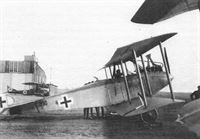
Описание
Страна: Германия
Год: 1916
Варианты
- Aviatik - C.I/C.Ia - 1915 - Германия
- Aviatik - C.II - 1916 - Германия
- Aviatik - C.III - 1916 - Германия
- В.Кондратьев Самолеты первой мировой войны
- O.Thetford, P.Gray German Aircraft of the First World War (Putnam)
- J.Herris Aviatik Aircraft of WWI (A Centennial Perspective on Great War Airplanes 10)
- M.Dusing German Aviation Industry in WWI. Volume 1 (A Centennial Perspective on Great War Airplanes 84)
- Журнал Flight
-
J.Herris - Aviatik Aircraft of WWI /Centennial Perspective/ (10)
Aviatik C.III serving with Flieger-Abteilung 25.
-
J.Herris - Aviatik Aircraft of WWI /Centennial Perspective/ (10)
Aviatik C.III that served with Flieger-Abteilung (A) 209 before being interned in the Netherlands.
-
J.Herris - Aviatik Aircraft of WWI /Centennial Perspective/ (10)
Aviatik C.III trainer.
-
O.Thetford, P.Gray - German Aircraft of the First World War /Putnam/
Aviatik C.Ia 1750/16 was the aerodynamic test-bed and prototype for the Aviatik C.III powered by the same 160 hp Mercedes D.III engine as the C.I. The C.Ia gained a useful speed increase from its additional streamlining. The later Aviatik C.II also benefited from these aerodynamic improvements although it used a different engine and airframe.
-
J.Herris - Aviatik Aircraft of WWI /Centennial Perspective/ (10)
An Aviatik C.III in dark camouflage, an unusual finish for a C.III.
-
M.Dusing - German Aviation Industry in WWI. Volume 1 /Centennial Perspective/ (84)
Aviatik C.III (1916)
-
J.Herris - Aviatik Aircraft of WWI /Centennial Perspective/ (10)
Based on its fuselage insignia, this Aviatik C.III apparently served with Flieger-Abteilung (A) 209 before being interned in the Netherlands, as shown by the over-painted national insignia. The pointed spinner differs from the more rounded spinner normally seen on Aviatik C.III aircraft.
-
J.Herris - Aviatik Aircraft of WWI /Centennial Perspective/ (10)
An operational Aviatik C.III aircrew poses with their ground crew and their aircraft. The starboard gun is clearly visible.
-
J.Herris - Aviatik Aircraft of WWI /Centennial Perspective/ (10)
The Aviatik C.III, developed from the C.I, used the same 160 hp Mercedes D.III engine but was much more streamlined, making it faster than the C.I. Unfortunately, at Idflieg's insistence it retained the observer in the front cockpit and the side-mounted guns, making for a cramped working environment and restricted field of fire.
-
J.Herris - Aviatik Aircraft of WWI /Centennial Perspective/ (10)
The Aviatik C.III had clean lines for a two-seater; this example has the rounded spinner normally seen on the C.III.
-
J.Herris - Aviatik Aircraft of WWI /Centennial Perspective/ (10)
An Aviatik C.III displays the clean lines that made it usefully faster than the C.I despite using the same engine, a 160 hp Mercedes D.III.
-
J.Herris - Albatros Aircraft of WWI. Volume 2: Late Two-Seaters /Centennial Perspective/ (25)
Feld-Flieger Abteilung 25 lineup has an Aviatik C.III in the left foreground with Albatros C.V/16 1212/16 in the center background. The wet, muddy airfield conditions were harsh on both men and machines.
Другие самолёты на фотографии: Albatros C.V - Германия - 1916
-
M.Dusing - German Aviation Industry in WWI. Volume 2 /Centennial Perspective/ (85)
Mercedes D.IIIa were used on Aviatik C.III aircraft.
-
J.Herris - Aviatik Aircraft of WWI /Centennial Perspective/ (10)
Aviatik C.III 12310/17 was ordered as a trainer; in this configuration the pilot sat in the front cockpit.
-
J.Herris - Aviatik Aircraft of WWI /Centennial Perspective/ (10)
An Aviatik C.III in pristine condition waits in the snow for its next mission. Absence of the gun-mounting rails along the forward fuselage sides indicates this aircraft was ordered as a trainer with the pilot seated in the front cockpit.
-
J.Herris - Aviatik Aircraft of WWI /Centennial Perspective/ (10)
An Aviatik C.III in Netherlands service postwar.
-
J.Herris - Aviatik Aircraft of WWI /Centennial Perspective/ (10)
An armed Aviatik C.III and crewman.
-
J.Herris - Aviatik Aircraft of WWI /Centennial Perspective/ (10)
The restored fuselage of Aviatik C.III 12250/17, one of the 200 ordered for training, in the museum in Poland. To its left is the fuselage of Roland D.VIb 2225/18.
Другие самолёты на фотографии: LFG Roland D.VI - Германия - 1918
-
J.Herris - DFW Aircraft of WWI /Centennial Perspective/ (29)
Early Aviatik nameplate, here from an Aviatik C.III. An identical nameplate was fastened to the front of the fuselage on licence-built DFW C.V aircraft from early Aviatik batches. ((c) Piotr Mrozowski)
-
J.Herris - Aviatik Aircraft of WWI /Centennial Perspective/ (10)
Aviatik C.III 12378/17 has lost its spinner and broken its propeller in a training accident.
В.Кондратьев Самолеты первой мировой войны
АВИАТИК C-I/C-Ia/C-III / AVIATIK C-I/C-Ia/C-III
<...>
В том же году был разработан "Авиатик" C-III с улучшенной аэродинамикой. Форму носовой части фюзеляжа сделали более округлой, втулку винта закрыли коком, а радиатор расположили по потоку, вписав его в контур верхнего крыла. C-Ia и C-III повсеместно использовались германскими ВВС до конца 1916-го для ближней разведки, корректировки артогня и бомбардировки вражеских позиций. В дальнейшем заменены на более современные машины.
ДВИГАТЕЛЬ
"Мерседес", 160 л.с. (C-I, C-Ia и C-III).
ВООРУЖЕНИЕ
На C-I, C-Ia и C-III - 1 7,92-мм турельный "Парабеллум", 60 кг бомб.
Описание:



























